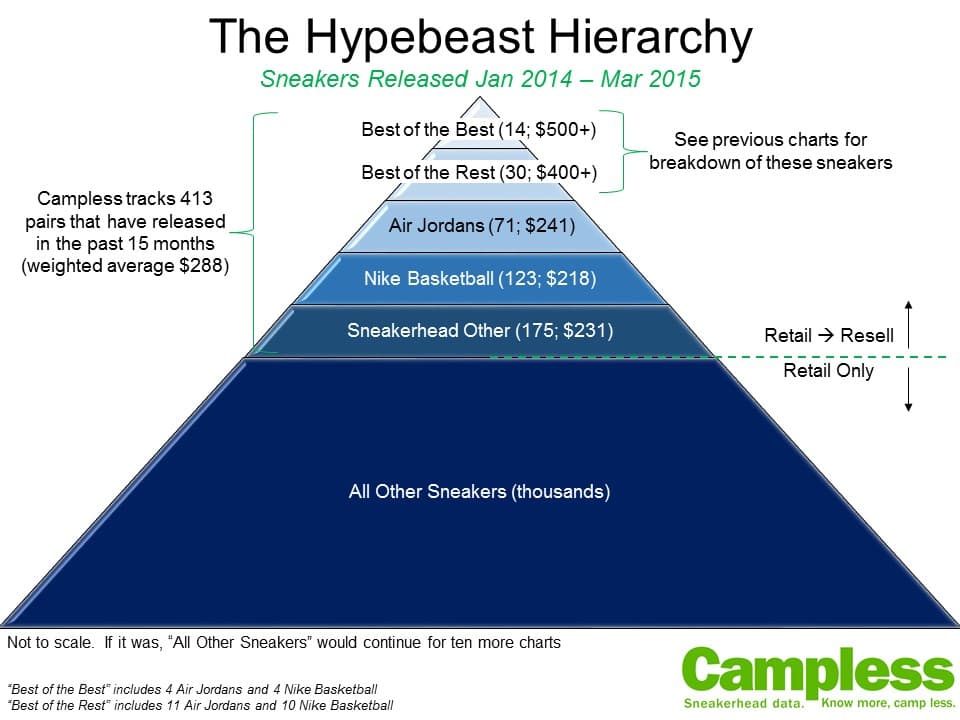Quick question: How many shoes that released in the past year now resell for more than $500?
You almost certainly guessed too high.
Earlier this week High Snobiety published the first of a recurring, quarterly collaboration piece tracking the top reselling shoes. Using Campless data for average deadstock resell price and total dollars sold, graphic designer @KickPosters created several outstanding charts, bringing the data to life. With such a public celebration of 2015 first quarter kicks, this seemed like a perfect time to go deeper on the topic.
How do the most expensive resell kicks influence the rest of the market?
The hyperstrikes – those ultra-limited, mega-desired sneakers which drive all of the hype and all of the crazy – are actually few and far between. While stories of $15K Yeezys, $37K Eminem 4s and $71K Air Ships dominate the headlines, the reality is that there are only one or two true hyperstrikes released each month. In fact, in the 15 months from January 1 2014 through March 31 2015, there were only 14 pairs which had a proper U.S. release and enough volume to rise to the level of “Best of the Best”:
Methodology: Best of the Best list qualifications: A) Released in the United States during the relevant 15-month time period; B) Average resell price at least $500 based on eBay sales for deadstock pairs during the 12 months ending March 31, 2015; C) At least 35 pairs sold on eBay during the past 12 months.
Debatable Inclusions: Arguably, we could have excluded the Nike Roshe Run Boxtrolls and the Nike LeBron 12 NBA 2K14, as neither of these shoes had a “true” release. However, due to the high volume of pairs available (Boxtrolls had 744 eBay sales; LBJ 2K14 had 637), we decided to leave them on the list.
Notable Exclusions: What is a “true” release? Every sneaker listed on each of these charts (above and below) was actually, physically and legally put into the market (i.e., released). On the other hand, some of these releases were so limited – in both quantity and geography – that there wasn’t a real chance for your average sneakerhead to cop, even using the latest ATC services. For example, the Air Jordan 1 TedX was only available as part of the Portland TedX conference in April 2014 and limited to just 230 pairs. Similarly, the adidas Stan Smith Colette, Nike Foamposite One Tiajin and Kobe 9 HTM were released in France, China and Italy, respectively.
The following chart shows the next rung down…eleven $500+ pairs that were excluded from the Best of the Best, and nineteen pairs which resell for $400-499. This is the Best of the Rest:
If a review of the two “Best of” lists is starting to feel like a pyramid, that’s not a coincidence. When we break down all sneakers that Campless tracks (which is loosely defined as those sneakers which sell for more on the resell market than at retail) we quickly see a very familiar shape. Bill Simmons famously introduced us to his pyramid-shaped NBA Hall of Fame. Why can’t we do the same for sneakers?
We’ve jokingly named this chart the “Hypebeast Hierarchy” because it assumes that demand is purely a function of hype and potential resell price. This is not to say that every shoe in every tier is more hyped and more expensive than every shoe in the tier below it. Rather, these are aggregate conclusions from the sum of the data (plus a little personal experience). In fact, we can see that the average price of the “Sneakerhead Other” is actually less than “Nike Basketball”, but that is largely a function of the fact that we track every LeBron, Kobe and Durant, even GR pairs which sell for less than retail on eBay.
A more positive interpretation of the pyramid is that the hyperstrikes – the Best of the Best and Rest – are gateway drugs for new sneakerheads. As they discover the culture, market and community, their first purchases are usually here. But as they learn more about sneakers, their tastes expand and they buy more sneakers at both resell and retail. Most sneakerheads who have been in the game for more than a minute likely own as many shoes from the bottom tier than any other (I know I do). And from an equitable distribution system, that makes sense. Of course, distribution of limited release sneakers is never truly equitable, is it? But that’s an issue for another day (or blog).
What do you think? How would you change the pyramid?






















